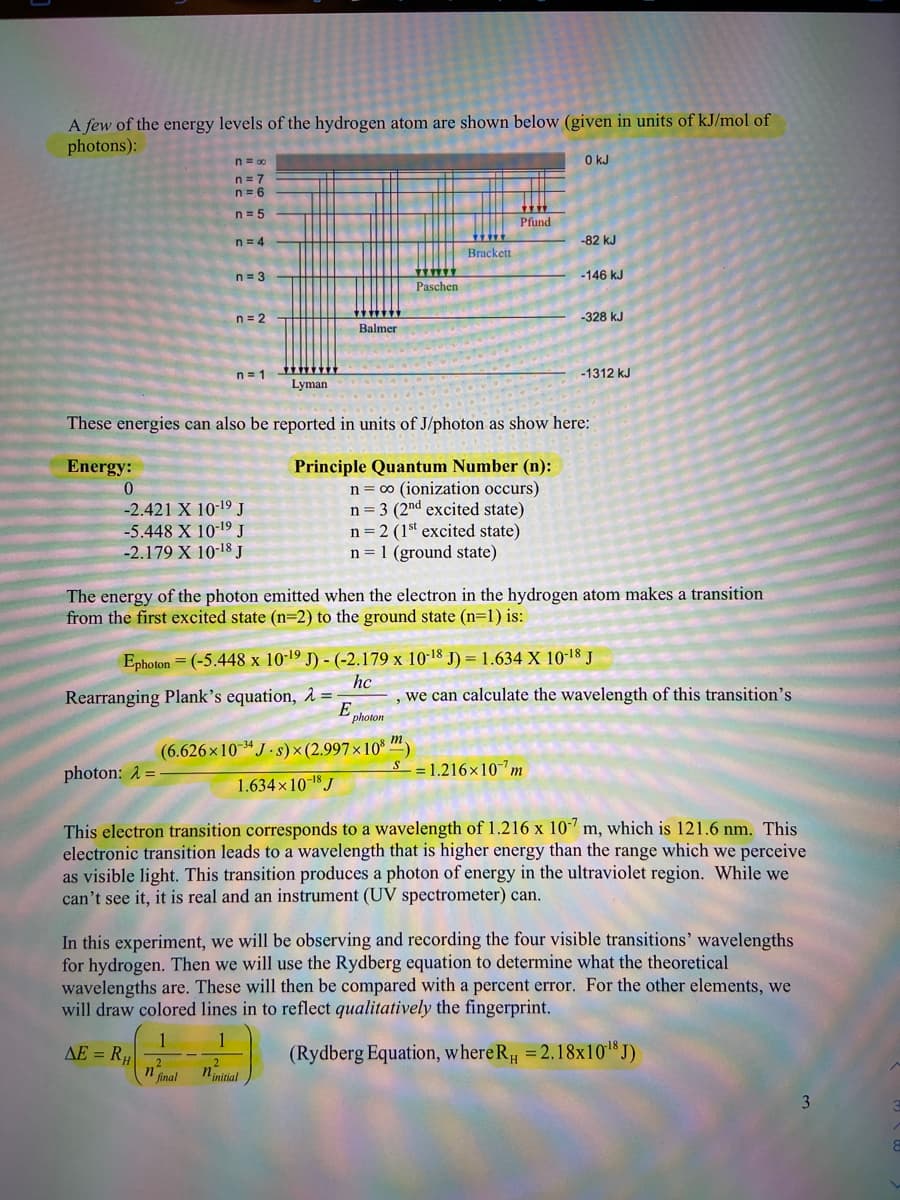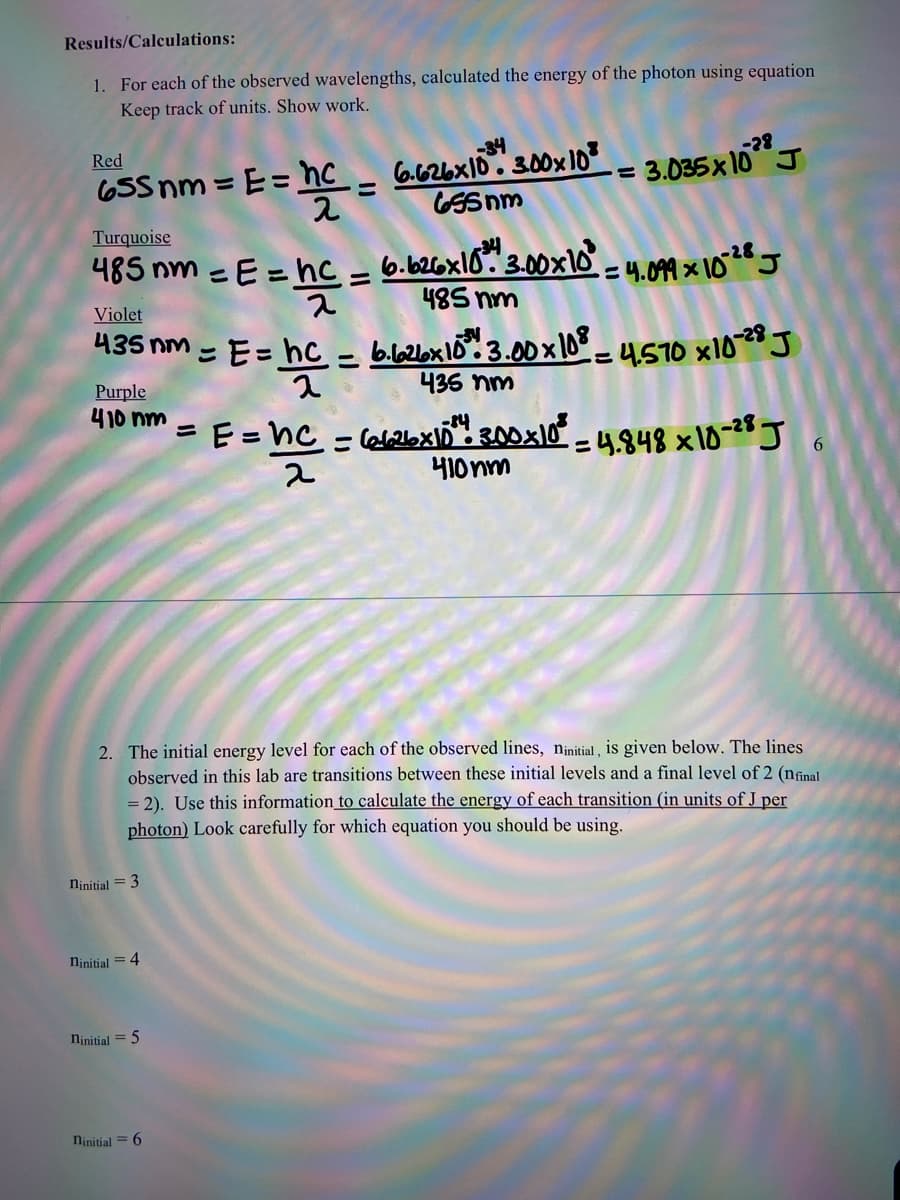Chemistry: The Molecular Science
5th Edition
ISBN:9781285199047
Author:John W. Moore, Conrad L. Stanitski
Publisher:John W. Moore, Conrad L. Stanitski
Chapter5: Electron Configurations And The Periodic Table
Section: Chapter Questions
Problem 114QRT
Related questions
Question
Hello!
I needed help with this part of my chemistry lab (#2). The first picture is the instructions in the the theory. And the second picture is part of the results/calculations. Thank you!

Transcribed Image Text:A few of the energy levels of the hydrogen atom are shown below (given in units of kJ/mol of
photons):
n = oc
OkJ
n = 7
n = 6
n = 5
Pfund
n = 4
-82 kJ
Brackett
n = 3
-146 kJ
Paschen
n = 2
-328 kJ
Balmer
n= 1
-1312 kJ
Lyman
These energies can also be reported in units of J/photon as show here:
Principle Quantum Number (n):
n = c0 (ionization occurs)
n= 3 (2nd excited state)
n=2 (1st excited state)
n = 1 (ground state)
Energy:
-2.421 X 10-19 J
-5.448 X 10-19 J
-2.179 X 10-18 J
The energy of the photon emitted when the electron in the hydrogen atom makes a transition
from the first excited state (n=2) to the ground state (n=1) is:
Ephoton = (-5.448 x 10-19 J) - (-2.179 x 10-18 J) = 1.634 X 10-18 J
hc
Rearranging Plank's equation, 1 =
, we can calculate the wavelength of this transition's
E
photon
(6.626x10-34 J . s)× (2.997×10* ")
photon: 1 =
S =1.216×10m
1.634x10 18 J
This electron transition corresponds to a wavelength of 1.216 x 10" m, which is 121.6 nm. This
electronic transition leads to a wavelength that is higher energy than the range which we perceive
as visible light. This transition
can't see it, it is real and an instrument (UV spectrometer) can.
ices a photon of energy in the ultraviolet region. While we
In this experiment, we will be observing and recording the four visible transitions' wavelengths
for hydrogen. Then we will use the Rydberg equation to determine what the theoretical
wavelengths are. These will then be compared with a percent error. For the other elements, we
will draw colored lines in to reflect qualitatively the fingerprint.
1
AE = RH
n final
(Rydberg Equation, where R, =2.18x10 J)
ninitial

Transcribed Image Text:Results/Calculations:
1. For each of the observed wavelengths, calculated the energy of the photon using equation
Keep track of units. Show work.
-34
-28
3.035X10J
Red
6SS nm = E= hc
6.626x10.300x 10
Turquoise
485 nm - E = hc = b.b26x10"3.00x10 = 4.0o9 x10?J
485 nm
%3D
Violet
435 nm
E= hc
blozlox 10"3.00x 108_
4570 x1028 J
435 nm
Purple
410 nm
%3D
= 4,848 x10-28J
6.
2
410nm
2. The initial energy level for each of the observed lines, ninitial, is given below. The lines
observed in this lab are transitions between these initial levels and a final level of 2 (ninal
= 2). Use this information to calculate the energy of each transition (in units of J per
photon) Look carefully for which equation you should be using.
ninitial = 3
Ninitial = 4
Ninitial = 5
Ninitial = 6
Expert Solution
This question has been solved!
Explore an expertly crafted, step-by-step solution for a thorough understanding of key concepts.
This is a popular solution!
Trending now
This is a popular solution!
Step by step
Solved in 2 steps with 2 images

Knowledge Booster
Learn more about
Need a deep-dive on the concept behind this application? Look no further. Learn more about this topic, chemistry and related others by exploring similar questions and additional content below.Recommended textbooks for you

Chemistry: The Molecular Science
Chemistry
ISBN:
9781285199047
Author:
John W. Moore, Conrad L. Stanitski
Publisher:
Cengage Learning

Principles of Modern Chemistry
Chemistry
ISBN:
9781305079113
Author:
David W. Oxtoby, H. Pat Gillis, Laurie J. Butler
Publisher:
Cengage Learning

Chemistry: Principles and Practice
Chemistry
ISBN:
9780534420123
Author:
Daniel L. Reger, Scott R. Goode, David W. Ball, Edward Mercer
Publisher:
Cengage Learning

Chemistry: The Molecular Science
Chemistry
ISBN:
9781285199047
Author:
John W. Moore, Conrad L. Stanitski
Publisher:
Cengage Learning

Principles of Modern Chemistry
Chemistry
ISBN:
9781305079113
Author:
David W. Oxtoby, H. Pat Gillis, Laurie J. Butler
Publisher:
Cengage Learning

Chemistry: Principles and Practice
Chemistry
ISBN:
9780534420123
Author:
Daniel L. Reger, Scott R. Goode, David W. Ball, Edward Mercer
Publisher:
Cengage Learning


Chemistry for Engineering Students
Chemistry
ISBN:
9781337398909
Author:
Lawrence S. Brown, Tom Holme
Publisher:
Cengage Learning

Chemistry
Chemistry
ISBN:
9781305957404
Author:
Steven S. Zumdahl, Susan A. Zumdahl, Donald J. DeCoste
Publisher:
Cengage Learning